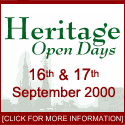-
Coventry's
civic charter dates from 1345 and was the first of a new kind of
municipal charter in England.
-
In
1381, John Ball, the renegade priest who led the ill-fated
Peasants' Revolt, fled to Coventry, but was discovered hiding in a
house in the city and taken prisoner.
-
John
Onley, mayor in 1396, was the first Englishman born in Calais
after the town became an English possession.
-
In
1397, Richard II sealed his own fate by banishing into exile two
warring barons, the Dukes of Norfolk and Hereford, at a famous
tournament in Coventry. Hereford returned two years later to usurp
the throne as Henry IV.
-
Royal
Parliaments were held in Coventry in 1404 and 1459, the first
dubbed the 'Unlearned' Parliament because the king refused to
allow lawyers to stand as members.
-
During
a visit by Henry VI in 1451, Coventry was granted the status of a
county, separate from Warwickshire. Its independence lasted until
1842.
-
Two
days after his victory over Richard III at Bosworth Field in 1485,
Henry VII marched to Coventry and was rapturously received by the
citizens, who had hastily changed sides.
-
In
the autumn of 1520 the mayor, John Bond, ordered a detailed count
to be taken of every inhabitant of the city. It is the earliest
surviving complete census of an urban population in Britain.
-
In
1605, the Gunpowder Plotters planned to seize James I's daughter
Elizabeth from nearby Coombe Abbey, where she was being educated,
and proclaim her queen. Word leaked out and she was hastily
evacuated to fortified Coventry.
-
Colonel
William Purefoy, one of the regicides who signed Charles I's death
warrant in 1649, was governor and MP for Coventry in the 1650s.
-
Daniel
Defoe, during a visit in 1722, was shocked to see aldermen and
even magistrates leading the street fighting during a particularly
violent Coventry election.
-
Hertford
Street, completed in 1820, was paid for by confiscated union dues
paid to the Weavers' Provident Union. They amounted to £16,000.
-
Radical
writer and thinker William Cobbett stood as a candidate in the
1821 Parliamentary election and found himself shot at and oughed
up by a mob.
-
Another
bout of street fighting, during the 'reform' election of 1832,
pitted pugilists from Birmingham against navvies from the Oxford
Canal, then under construction.
-
Joseph
Paxton, designer of the Crystal Palace, was Liberal MP for
Coventry in the 1860s. His architectural practice had also
designed Coventry's new municipal cemetery, 20 years before.
-
Siegfried
Bettmann, founder of the Triumph company, was mayor of the city in
1913, but was hounded out of office the following year because of
his German background.
-
In
1937, Alice Arnold became Coventry's first woman mayor.
-
Coventry's
City Treasurer from 1922 to 1944 was Sidney Larkin, father of
Philip Larkin, the poet.
-
After
the November 1940 Blitz, the government wanted to declare martial
law in Coventry, fearing widespread civil disorder. Only
impassioned pleas by civic leaders forced ministers to change
their minds.
-
Coventry's
wartime experiences prompted it to become the most enthusiastic of
twin towns, with 26 friendship links around the world. The first
was Stalingrad, now Volgograd, in 1944, the most recent Jinan in
China in 1983.

